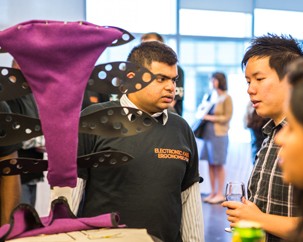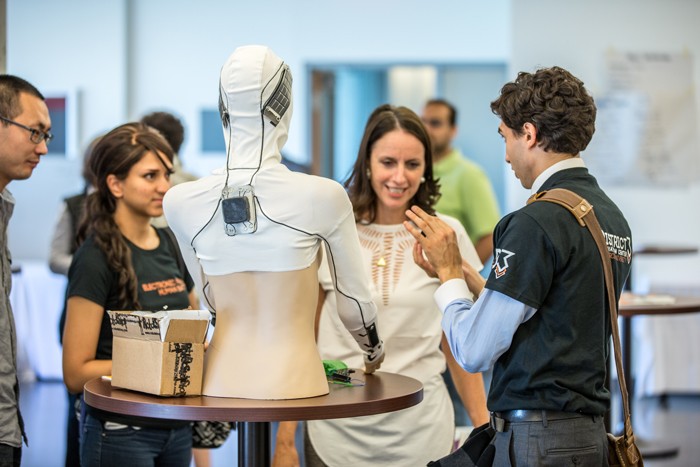District 3’s 10 prototypes of the future
From an inflatable plant-growing bed to a laser-welder and a chair made from electronic fabrics, Concordia’s District 3 Innovation Center had no shortage of projects on the go this summer.
From June through September, District 3 was a hive of multidisciplinary activity that brought students and business leaders together on 10 wildly diverse projects. All are now in various stages of completion, with some ready for venture capital and others finalizing working prototypes.
On September 5 — a crisp early autumn evening — the student teams, their industry mentors, and faculty and staff gathered for the District 3’s first Innovation Award Ceremony.
“It’s been a great opportunity,” said Andrew Sutherland, a former member of the Edmonton Police Force. He was one of the business representatives who came to District 3 with a specific challenge: to create an “innovative breaching device,” something to help law enforcement officers safely smash down doors.
The resulting project, Law Enforcement, ended up clinching the Creativity Process prize, one of four awards decided by a panel of business and industry experts.
 Students Rabbani Basha Mohammad (left) and Lambert Le with a prototype for the Electronic Fabric Chair project.
Students Rabbani Basha Mohammad (left) and Lambert Le with a prototype for the Electronic Fabric Chair project.
Sutherland “brought the problem and the solution to District 3,” he said. District 3’s role, according to Concordia electrical engineering student Ryan Desgroseilliers, was “to take the conceptual design and turn it into a functioning prototype.”
The mandate for the Law Enforcement project came from John Brkich, founder of Forensics Technology, a company that has spent more than two decades performing the kind of work made famous by the CSI television series. Among Forensics Technology’s many product offerings are ballistics identification technologies and software.
It was safety of a very different kind that was the intent behind the Ergonomic Chair project, requested by Joanna Berzowska, chair of the Department of Design and Computation Arts.
Berzowska wanted a seat that would encourage good posture, thus avoiding the risk of a bad back and muscle strain: she knew that there was considerable potential in the use of electronic fabrics, which could make the chair “aware” of its occupant. The Electronic Fabric Chair team ended up taking home the Jury’s Favourite prize.
Heavier-duty industry was the focus of the project that the industrial instrumentation company Intempco brought to District 3. Intempco manufactures temperature and humidity sensors; it wanted a laser-welder to replace a pre-existing machine of less-than-optimal efficiency. The result, Laser, won the Validated Prototype prize.
VerAvenir completed the awards line-up with the Multidisciplinary Team prize. The team pitched in on a project that seeks to do nothing less than transform agricultural practises: they created a patented inflatable growing bed that reduces the amount of energy consumed by greenhouses and eliminates the need for pesticides.
The spirit of the evening was summed up by Sutherland: “Coming to students, including young engineers, is very exciting because their skills are cutting edge. Plus, I get to spend time here,” adding that he came all the way from Edmonton for the event. “I love Concordia and I love Montreal!”
